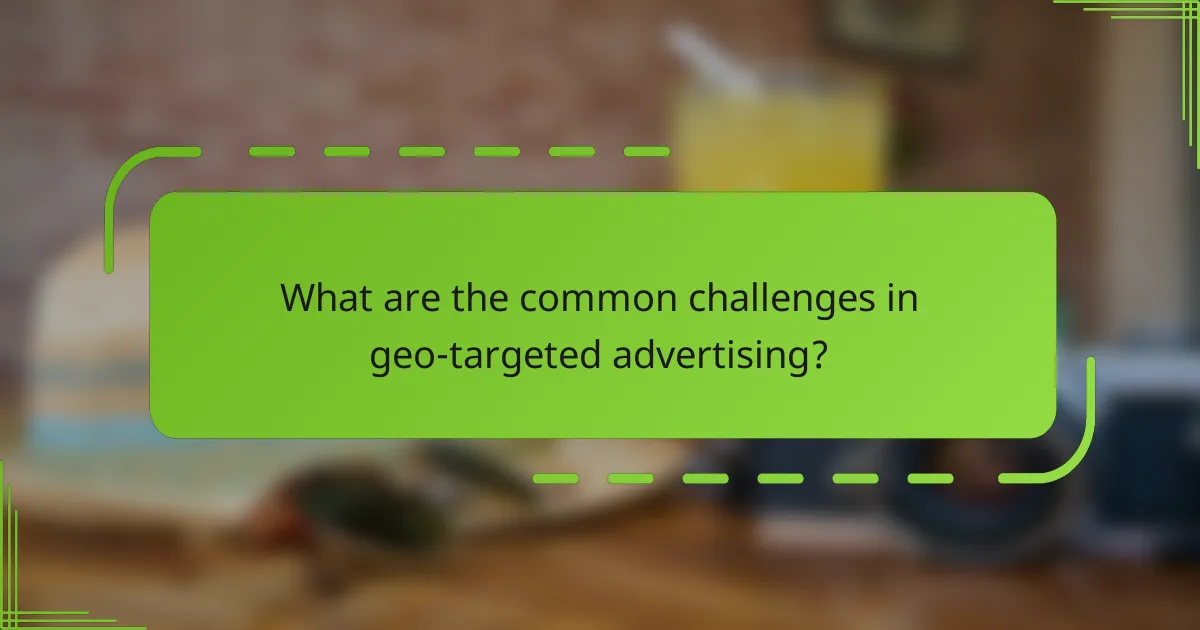Geo-targeted ads integrated with social media strategies offer businesses in Georgia a powerful way to connect with local audiences. By leveraging location data, companies can deliver tailored content that resonates with users, enhancing engagement and increasing conversion rates. Platforms like Facebook, Instagram, and Twitter are particularly effective for reaching specific demographics, allowing for a more focused marketing approach that aligns with local preferences.

How to effectively integrate geo-targeted ads with social media strategies in Georgia?
Integrating geo-targeted ads with social media strategies in Georgia involves using location data to reach specific audiences effectively. This approach enhances engagement by delivering relevant content to users based on their geographic location.
Utilizing Facebook Ads for local targeting
Facebook Ads offers robust tools for local targeting, allowing businesses in Georgia to reach users based on their location. Advertisers can set specific geographic parameters, such as cities or regions, ensuring that their ads are shown to the most relevant audience.
To maximize effectiveness, consider using local language and cultural references in your ad copy. This resonates better with the target audience and increases the likelihood of engagement. Additionally, monitor ad performance regularly to adjust targeting settings as needed.
Leveraging Instagram’s geo-tagging features
Instagram’s geo-tagging features enable businesses to tag their posts and stories with specific locations, enhancing visibility among local users. This feature is particularly useful for promoting events or special offers that are location-specific.
Encourage customers to use geo-tags when sharing their experiences with your brand. This user-generated content can amplify your reach and build community engagement. Use relevant hashtags alongside geo-tags to further increase discoverability among local audiences.
Implementing location-based promotions
Location-based promotions are an effective way to drive foot traffic to physical stores in Georgia. Consider offering exclusive discounts or deals to users who are within a certain radius of your business, incentivizing them to visit.
Utilize social media platforms to announce these promotions, ensuring that the messaging is clear and compelling. Additionally, track the success of these promotions to refine future strategies and understand what resonates best with your audience.

What are the benefits of geo-targeted ads on social media?
Geo-targeted ads on social media provide businesses with the ability to reach specific audiences based on their location, leading to more relevant messaging and improved marketing effectiveness. By tailoring ads to local demographics, companies can enhance user engagement and increase the likelihood of conversions.
Increased engagement rates
Geo-targeted ads significantly boost engagement rates by delivering content that resonates with local audiences. When users see ads that reflect their community or regional interests, they are more likely to interact with the content, whether through likes, shares, or comments.
For example, a restaurant promoting a special offer to users within a 10-kilometer radius can expect higher engagement than a generic ad. This localized approach ensures that the message is relevant, increasing the chances of user interaction.
Higher conversion rates
Higher conversion rates are another key benefit of geo-targeted ads, as they focus on users who are more likely to take action based on their proximity to a business. By targeting ads to specific locations, companies can drive foot traffic and online sales more effectively.
A study might show that businesses using geo-targeting see conversion rates increase by 20-30% compared to non-targeted campaigns. This is particularly effective for local services, such as delivery or in-store promotions, where immediate access is crucial.

What platforms are best for geo-targeted advertising in Georgia?
In Georgia, the most effective platforms for geo-targeted advertising include Facebook, Instagram, and Twitter. These platforms allow businesses to reach specific audiences based on location, making it easier to tailor marketing strategies to local preferences and behaviors.
Facebook is a leading platform for geo-targeted advertising due to its extensive user base and advanced targeting options. Advertisers can create campaigns that focus on specific cities, regions, or even neighborhoods in Georgia, ensuring that ads reach the most relevant audience.
Utilizing Facebook’s location targeting features, businesses can set parameters such as radius targeting around a physical location or targeting users who have recently visited a specific area. This can be particularly effective for local businesses looking to attract nearby customers.
Instagram, owned by Facebook, offers similar geo-targeting capabilities, making it an ideal choice for visually-driven campaigns. Brands can leverage location tags in posts and stories to enhance visibility among local users in Georgia.
Instagram ads can be tailored to specific demographics and locations, allowing businesses to connect with potential customers through engaging visuals. Using local influencers can further amplify the reach of geo-targeted ads, creating a stronger community connection.
Twitter provides geo-targeted advertising options that allow businesses to reach users based on their location. Advertisers can target specific areas in Georgia, making it suitable for time-sensitive promotions or events.
While Twitter’s user base is smaller than that of Facebook and Instagram, its real-time nature can be advantageous for campaigns that require immediate engagement. Utilizing trending hashtags and location-based tweets can enhance the effectiveness of geo-targeted ads on this platform.

How to measure the effectiveness of geo-targeted ads?
Measuring the effectiveness of geo-targeted ads involves analyzing various performance metrics that indicate how well these ads resonate with specific local audiences. Key indicators include engagement rates, conversion rates, and return on investment (ROI) specific to the targeted regions.
Using analytics tools
Analytics tools are essential for assessing the performance of geo-targeted ads. Platforms like Google Analytics and Facebook Insights allow advertisers to track user interactions based on geographic data. By setting up location-based filters, businesses can see how ads perform in different regions, helping to refine targeting strategies.
Consider integrating tools that provide heat maps or geographic breakdowns of user engagement. This visual data can highlight which areas are responding best to your campaigns, enabling more focused ad spending.
Tracking conversion metrics
Tracking conversion metrics is crucial for understanding the effectiveness of geo-targeted ads. Metrics such as click-through rates (CTR) and conversion rates should be monitored closely to evaluate how well ads convert views into actions, like purchases or sign-ups, in specific locations.
Establish clear conversion goals for each region and use tracking pixels or UTM parameters to measure success accurately. Regularly reviewing these metrics can help identify trends and optimize future campaigns, ensuring that ad spend is directed towards the most profitable areas.

What are the common challenges in geo-targeted advertising?
Geo-targeted advertising faces several challenges that can hinder its effectiveness. Key issues include data privacy concerns, which affect user trust, and ad fatigue, where local audiences become overwhelmed by repetitive ads.
Data privacy concerns
Data privacy is a significant challenge in geo-targeted advertising, especially with increasing regulations like GDPR in Europe. Advertisers must navigate complex laws while ensuring they respect user privacy, which can limit the data available for targeting.
To address these concerns, businesses should prioritize transparency in their data collection practices. Informing users about how their data will be used can help build trust and encourage engagement.
Ad fatigue in local markets
Ad fatigue occurs when local audiences see the same advertisements too frequently, leading to decreased engagement. This is particularly common in smaller markets where the audience size is limited, and the same ads are shown repeatedly.
To combat ad fatigue, consider rotating ad creatives regularly and diversifying messaging. Utilizing A/B testing can help identify which ads resonate best with local audiences, allowing for more effective targeting.

How to optimize social media ads for local audiences?
To optimize social media ads for local audiences, tailor your content to resonate with the specific cultural and social dynamics of the area. This involves understanding local preferences, language nuances, and community values to create impactful advertisements.
Customizing ad content for local culture
Customizing ad content for local culture means incorporating local dialects, symbols, and references that resonate with the target audience. For instance, using regional slang or showcasing local landmarks can enhance relatability and engagement.
Consider seasonal events or local traditions when designing your ads. For example, promoting a product during a local festival can increase visibility and relevance. Always ensure that the imagery and messaging align with community values to avoid misinterpretation.
Using local influencers
Engaging local influencers can significantly amplify the reach of your social media ads. These individuals often have established trust and credibility within their communities, making their endorsements more impactful than traditional advertising.
When selecting influencers, look for those whose audience aligns with your target demographic. Collaborating with them on campaigns can include product reviews, giveaways, or co-hosting events, which can effectively drive local engagement and sales.

What are the prerequisites for successful geo-targeted ad campaigns?
Successful geo-targeted ad campaigns require a clear understanding of the target audience and well-defined objectives. By focusing on local demographics and setting specific goals, businesses can create more effective and relevant advertisements that resonate with their audience.
Understanding local demographics
To effectively reach your audience, you must analyze the local demographics of the area you are targeting. This includes factors such as age, gender, income levels, and cultural preferences. For instance, a campaign aimed at younger consumers in urban areas may differ significantly from one targeting older adults in rural settings.
Utilizing tools like social media analytics and market research can provide insights into the preferences and behaviors of local consumers. This information allows you to tailor your messaging and offers to meet the specific needs of your audience, increasing engagement and conversion rates.
Setting clear campaign objectives
Establishing clear objectives is crucial for the success of geo-targeted ad campaigns. Objectives should be specific, measurable, achievable, relevant, and time-bound (SMART). For example, a goal could be to increase foot traffic to a local store by 20% over the next three months.
Moreover, aligning your campaign objectives with local events or seasonal trends can enhance relevance. For instance, promoting a special offer during a local festival can attract more attention and drive sales. Regularly reviewing and adjusting your objectives based on performance metrics will help optimize your campaigns for better results.

What emerging trends in geo-targeted advertising should marketers watch?
Marketers should pay attention to the increasing use of artificial intelligence and machine learning in geo-targeted advertising, as these technologies enhance personalization and targeting accuracy. Additionally, the rise of mobile usage and location-based services is reshaping how businesses engage with consumers in specific geographic areas.
Increased Personalization through AI
Artificial intelligence is enabling marketers to analyze vast amounts of data to create highly personalized ads based on user behavior and location. This trend allows for dynamic ad content that changes based on the viewer’s preferences and geographical context, improving engagement rates significantly.
For example, a restaurant can use AI to send tailored promotions to users who are nearby during lunch hours, increasing the likelihood of immediate visits. Marketers should invest in AI tools that integrate with their existing advertising platforms to leverage this capability effectively.
Mobile-First Strategies
With the majority of consumers accessing content via mobile devices, geo-targeted advertising strategies must prioritize mobile-first approaches. This includes optimizing ads for mobile viewing and ensuring that location services are utilized effectively to reach users in real-time.
Marketers should consider using push notifications and location-based offers that are triggered when potential customers are in proximity to their business. This tactic can lead to higher conversion rates, especially in urban areas where foot traffic is significant.
Integration with Social Media Platforms
Social media platforms are increasingly offering advanced geo-targeting options, allowing businesses to reach specific demographics based on location. Integrating geo-targeted ads with social media strategies can amplify brand visibility and engagement.
For instance, a local boutique can run Facebook ads targeting users within a certain radius, promoting special in-store events. Marketers should regularly review and adjust their social media ad settings to ensure they are reaching the right audience effectively.


